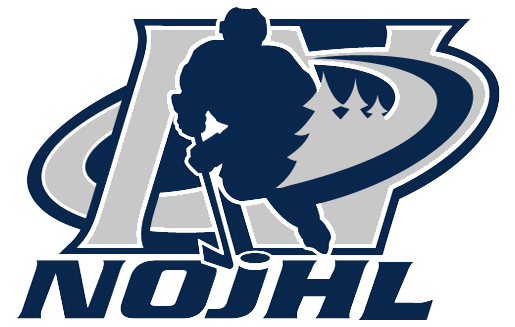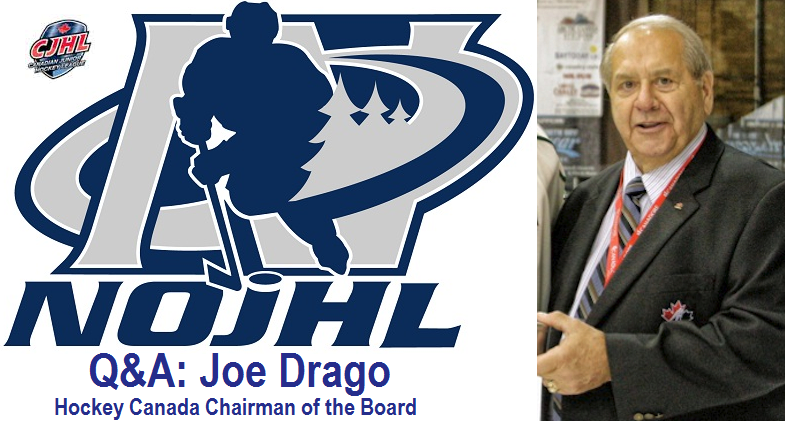NORTHERN ONTARIO JUNIOR HOCKEY LEAGUE
NOJHL MEDIA UPDATE
Release Date: Tuesday, April 7, 2015
NOJHL Q&A: With Hockey Canada Chairman of the Board Joe Drago
SUDBURY – When it comes to the Northern Ontario Junior Hockey League or the game in general, there are not many individuals who have done more over the years than Joe Drago.
Having spent nearly four decades in the game as a player, coach, manager or administrator, including a 12-year stint as NOJHL Commissioner, Drago has undoubtedly seen it all.
A life member of the Canadian Junior Hockey League and currently holding the prestigious position of Chairman of the Board for Hockey Canada, Drago recently took time out of his busy schedule to offer his thoughts about the game, the NOJHL and the CJHL in this special edition of NOJHL Q&A.
NOJHL: Give us your thoughts on being the first person from northern Ontario to serve as the Chairman of the Board of Directors for Hockey Canada.
JOE DRAGO: I don’t look at it as being as the first guy from northern Ontario; I look at it as an honour for anybody to be the Chairman of Hockey Canada.
Since I got there as the vice-chairman back a few years ago, I realized quickly how important the role of the Hockey Canada board is and the longer I stayed there the more I felt I could contribute more.
When the executive vice-chair position opened, I applied for that and then I thought, well, I’d like to take a chance at running for the chairman and have some influence on making some changes and continuing some of things that we’re already in existence.
I’m very proud and honoured to be there and I think it’s important that we have some representation in northern Ontario.
NOJHL: Do you have any particular special memories that stand out to you from your days as NOJHL Commissioner?
JD: I sure do. When I got in there as commissioner, the league was having some tough times and probably wasn’t going to exist for too much longer.
When you’re in small communities and there are no post-secondary facilities and people having to travel long distances for practices and games, it makes it pretty difficult.
What made me feel good was bringing in teams, at that time, like Rouyn-Noranda who was a tremendous addition to the league as were the Timmins Bears as was the Powassan Hawks, who were all strong, well-run franchises and gave the league credibility.
The Rayside-Balfour Sabrecats went all the way to the Royal Bank Cup in Fort McMurray, Alta., back in 2000.
I accompanied them to the Cup in Fort McMurray and to see them lose by one-goal, 2-1, to the host team was really disappointing because they had the team to win it all.
We got that far and it certainly gave the league and northern Ontario a lot of credibility in the Jr. A ranks.
Those teams operated so well and the southern Ontario clubs all felt we could give them a battle, so we met with the south and asked if we could have an interlocking schedule the one year.
That was really something that I cherish because we did agree to an interlocking schedule. It cost us a lot of money because we had to pay for hotel rooms and meals whereas when we went down there they didn’t give us anything back, so the agreement only lasted the one year, not because it wasn’t good, but we just couldn’t afford to do what was being done financially.
We won more of the games than the south did and the battles were hot and heavy.
When Rayside ended up meeting Milton in the finals, in those days the Dudley-Hewitt was a best-of-seven, and each arena was jammed every game and it was really good hockey. I was so proud of the Sabrecats when they beat Milton in that seventh game and from there we went to the Royal Bank Cup in Fort McMurray.
NOJHL: What was your favourite part about the job?
JD: My favourite part of the job was I had complete support from all the teams and all the managers and coaches.
When they asked me to do this job I had thought I was going to retire from the game, but the NOJHA, as it was known at that time, asked me if I’d go to a meeting and give them some guidance on some issues they were having.
So I went to the meeting and I did agree to help out and from there ended up being named commissioner.
My condition to taking the position was that I would have complete control and operate the league as I saw fit by doing some improvements and draft up a new constitution. I wanted them to know that you can’t have every team telling you what to do; you can’t have people that are coaches and managers hassling you when you are at a game. I told them when I’m at a game I don’t anybody bothering me, I’m there watching the game and I’m not there to argue about the officials or anything else.
So at our meetings we decided to try and not have coaches attend the meetings because most of the time you talk about officiating instead about what’s good for the game, good for your league and good for hockey in general.
I did get that kind of support. We had a good working relationship and I had a lot of fun. There were times of course we argued, but my method of operation was we could fight like heck in that boardroom, but when we walk out of there we’re all on the same page and we’re all supporting whatever took place in the meeting even if I didn’t like it or I voted against it.
There are so many things that can be done in that boardroom, no matter what team you are from when you’re there as a member of the board of directors of the league and you’re doing what’s best for the game and the kids that are playing.
NOJHL: What are some of the biggest differences you’ve seen from your tenure in the NOJHL to the current state of the league?
JD: The biggest difference now I think is the calibre of play.
More teams are better teams, on the ice. When I look back during my time then, the teams I mentioned did a great job. Then later on guys like Scott Marshall came in with Iroquois Falls and operated as a team should operate.
The calibre of play, the skill level of the players and the commitment of the fellas that are working there is very, very good these days.
However, the way the teams are put together now, it bothers me we have such a disparity between the top and the bottom. We are either very, very, very good or either very, very, very bad and I think you’ve got to bring that a lot closer together if you want to be a successful league. You can’t have bottom teams getting hammered because you see what happens with the crowds, you see what happens with sponsors, you see what happens with community interest.
One thing I’ve always heard from spectators and communities is, we want our team to win, but if they work hard are competitive are not getting trounced and it’s entertaining hockey, then we’re interested in going and supporting it.
NOJHL: What are some of the items you feel there needs to be more focus on in Jr. A hockey?
JD: I think there has to be more focus on getting away from fighting. As a player myself and as a coach I thought fighting was a big part of the game. But the more get involved at the level I’m at now and the more I meet and see what’s going on across the world, not just Canada, but the United States and Europe, when you see the skill level and you see how entertaining games are, I feel fighting can be eliminated a lot more than it is. I don’t think it’ll ever totally disappear, but when I look at the World Juniors and I look at the Olympics I see the way how people rally around those games. When you go to the World Juniors you just can’t believe how impressed people are with Canada, its team, the calibre of play.
We have to eliminate a lot of that useless fighting. When you hear terms like enforcer, it bothers me. There’s nothing like a good check, nothing like a good strong type of hockey game, but I don’t think the sticks or the hitting from behind and the head injuries and the number of concussions we see now makes people not want to be involved.
NOJHL: What advice would you have to players when are contemplating whether to play in the CJHL or go the major junior route?
JD: I went to school in the States on scholarship (Clarkson University), but my philosophy is I think there is a different avenue for each and every person. You have to look at the avenue you want to take. If you are going to think seriously about going to the NCAA, then you have to make sure you don’t lose your eligibility. If you want to go major junior and are good enough and if you meet with them and they give you all the details on what they are going to do for you as far as school is concerned, you do your analysis and make a decision. There is also the option of playing university or college in Canada, which is another very good path to take if it presents itself.
You have to take the avenue that suits you. If it’s the CJHL, you’re playing in the top Jr. A league and I think you’re treated very well and are getting the opportunity to develop. It can also open up other avenues from there in university or major junior.
NOJHL: Give us your thoughts on the role that the CJHL plays in Jr. A hockey in Canada.
JD: I’m very proud on what the CJHL has done the last few years. I think they have become much more professional on how they operate as a league, which is made up of the 10 Jr. A leagues from across the country.
They have a president in Kirk Lamb, they are extremely well organized, they meet regularly and they’ve become a league people enjoy and appreciate watching.
The CJHL has done a great job with exposure. We’ve seen the CJHL offer regional and national championships and showcase events such as the World Jr. A Challenge and Prospects games that gives an opportunity for players to showcase their talents further.
The CJHL has become much more professional, they’ve become more visible, the sponsors they have now are second to none and they’ve worked very, very hard to be active in their communities.
If you go to the RBC Cup it impresses you to no end the way the community takes over and become a real big part of the event. The last time I went, every store had signage in the window and the people were all over the place and the rink was packed to the rafters.
It’s a real highlight and credit to the CJHL.




















